
Cupping Therapy Page Menu: 1 2 3 4 5 Next>>
Cupping Therapy During the Golden Age of Piracy, Page 1
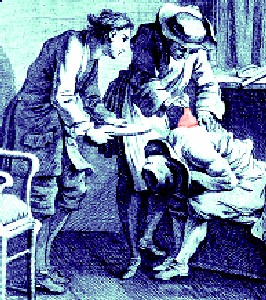
Artist: Jean-Baptiste Dudry
Cupping Ragotin to Reduce Swelling (early 18th c.)
Cupping therapy is the practice of burning the air out of a vessel with one opening and then placing that open port on a patient's skin. As the inside of the cupping vessel cools, a vacuum is formed, pulling against the skin. During the golden age of piracy, this procedure was used to draw the bodily humors - fluids and semi-fluids - to the surface of the skin. This was performed for a variety of reasons and in several ways as we shall soon see.
In their book Bloodletting Instruments in the National Museum of History and Technology, Audrey Davis and Tony Appel explain,
"Cupping was generally regarded as an auxiliary to venesection [bleeding a patient to remove 'bad' blood]. The indications for the operation were about the same as the indications for phlebotomy [bloodletting], except that there was a tendency to prefer cupping in cases of localized pain or inflammation, or if the patient was too young, too old, or too weak to withstand phlebotomy."1
Davis and Appel suggest cupping therapy was regarded as the 'second best' way to remove or divert humors in many cases, inferior to bloodletting. Several period surgical books bear this out, listing bloodletting as an alternative to phlebotomy2. Some surgeons even actively rejected the practice. Davis and Appel explain that in the 1725 edition of
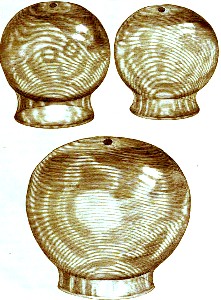
Cupping Glasses, from Exercitationes
Practicae Circa Medend Methodum,
by
Frederick Dekkers, p. 32 (1695)
his book Nouveau traité des instrumens de chirurgie, René-Jacques Croissant de Garengeot "accused the admirers of the ancients of wishing to kill patients 'with the pompous apparatus of wet cupping.'"3
However, many golden age of piracy era surgeons still advised the use of cupping therapy as a primary treatment in certain cases. For example, sea-surgeon John Atkins finds cupping to be "more expedient in Apoplectick [unconsciousness, usually caused by a stroke], Hysterick [uncontrollable overwrought emotional displays, frequently associated with women at this time], and Parlytick Cases, the Pain [removing pain] as well as drawing forth of Blood, irritating [the skin by drawing it into the cupping glass] and making Derivation [diverting humors from a wound site to another place]"4. Several other authors advised its use in various cases as well. So cupping had an important role in medicine at this time.
With this in mind, we will take a brief look at the history of cupping therapy in traditional European medicine. We will then discuss some of the theoretical underpinnings of cupping therapy, expanding on how cupping therapy was involved with humor theory. With the theory in place, we will move on to the practical aspects of cupping, beginning with the differences between wet and dry cupping and moving on to which diseases period and near-period authors felt should be treated by cupping therapy. This will be followed by an examination of cupping tools. We will finish with a look at how cupping was performed at this time and what was done for the patient after cupping.
1 Audry Davis and Toby Appel, Bloodletting Instruments in the National Museum of History and Technology, p. 17; 2 For some examples see: Ambroise Paré, The Workes of that Famous Chirurgion Ambrose Parey, p. 233, Richard Wiseman, Eight Chirurgicall Treatises, 3rd Edition, p. 297 & Guliielm. Fabritius Hildanus aka William Fabry, His Experiments in Chyrurgerie, p. 19; 3 Davis and Appel, p. 19; 4 John Atkins, The Navy Surgeon, p. 181;
Some Cupping Therapy History
The oldest known medical document, the Egyptian Ebers Papyrus, written around 1550 BC, "states that bleeding by wet cupping removes foreign matter from the body."1 Although cupping therapy is associated in many people's minds with oriental medicine, many of the earliest Western treatises on medicine discuss and advise its use. Hippocrates provides an account of how wet cupping should be performed to remove blood when treating ulcers. "Otherwise coagula of blood will be retained in the incisions and inflammatory ulcers will arise from them."2 In the first century AD, Roman Aulus Cornelius 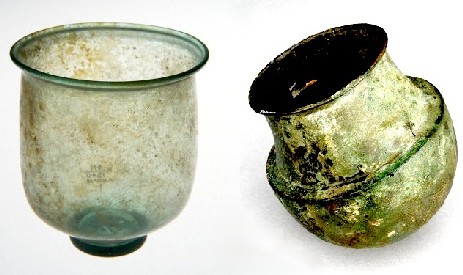
Source: Wellcome Museum, London, England
Ancient Cupping Vessels - Roman Cupping Glass (251 - 450 AD) and Egyptian Bronze
Cupping Container (300 BC - 300 AD)
Celsus suggests that cupping therapy was preferred over bloodletting, being used in a wide variety of cases.3
Bronze cupping containers were found at Pompeii.4 Cupping therapy was also "commonly employed at the Thermae [the Imperial bath] in ancient Rome, and a regular cupper was in attendance who carried with him his instruments, consisting of a set of metal cups, either of brass or bronze, a lamp and a scarifier."5
Closer to the golden age of piracy, French surgical teacher Pierre Dionis explained in 1733 that "Cupping is as ancient as Chirurgery [surgery]. Hippocrates mentions it, and Galen [of Pergamon, second century AD Greek surgeon and physician] boasts of its good Effects in the Cure of several Diseases. We cannot doubt but that the Application of Cupping Glasses has its Excellencies and Advantages"6.
Andrew Wear explains that although advances were being made in medicine in the late 17th and early 18th centuries, "a case can be made that most of the medicine remained unchanged. For instance, many therapeutic procedures such as the use of bleeding,
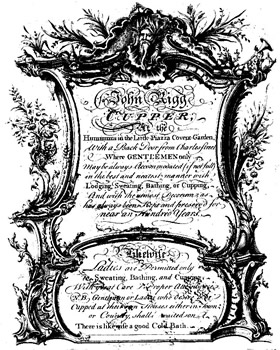
Source: Wellcome Museum, London, England
Cupper John Rigg's Trade Card - Used to Advertise
His Services (1750)
cupping, purging, the emphasis on diet and regimen (which was especially present in learned medicine) retained their popularity throughout the period"7.
By the 17th century, cupping had become so commonplace that the land-based surgeons rarely performed it, relegating it to the barber-surgeons. "The barber-surgeons were wound doctors who also performed bloodletting, cupping, the extraction of teeth, and the management of fractures, dislocations, and external ulcers."8 (For more on the barber-surgeons and surgeons, see The Ship's Surgeon as BARBER-Surgeon.) Within the barber-surgeon guild, cupping specialists even existed, who focused on this specific aspect of surgery, considering it to be a precision art, requiring "a high degree of dexterity that could be maintained only by constant practice."9
However, at sea the presence of a cupping specialist would have been most unusual. Certainly, no merchant ship would have the hired such a person. Since merchant ships were what pirates pursued, it is doubtful that they would have had the services of a professional cupper.
The surgeon would most likely have given cupping therapy to his assistants or perhaps even his surgeon's mates who were in training. As a result, cupping was probably not as nicely performed at sea as it would have been on land.
1 David K. Osborn, "Hijama, or Cupping", www.greekmedicine.net, gathered 11/9/14; 2 Hippocrates, Hippocratic Writings, Translated and Edited by Francis Adams, p. 148; 3 Dr. Charles John Samuel Thompson, The History and Evolution of Surgical Instruments, p. 76-7;4 Thompson, p. 76; 5 Thompson, p. 77; 6 Pierre Dionis, A course of chirurgical operations: demonstrated in the royal garden at Paris. 2nd ed., p. 471-2; 7 Andrew Wear, "Making sense of health and the environment in early modern England," Medicine in Society, p. 120-1; 8 Albert S. Lyons and R. Joseph Petrucelli II, Medicine: An Illustrated History, p. 454; 9 Audry Davis and Toby Appel, Bloodletting Instruments in the National Museum of History and Technology, p. 24
Cupping Therapy and Basic Humor Theory
"You may also let the Patient bloud [in wounds], by opening a Vein on the contrary part, if his strength will permit it, taking a little at a time only for Revulsion. You may use also Cupping, Friction, and Binding in the remote Parts, for Derivation." (Richard Wiseman, Eight Chirurgicall Treatises, 3rd Edition, p. 354)
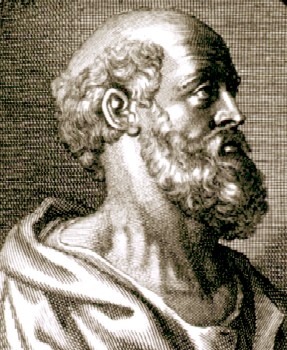
Hippocrates
The prevailing theory of how the body maintained its health at this time in history concerned humors - fluids and semi-fluids in the body. Hippocrates introduced the idea of humorism in his writings, explaining that the body contained "blood, pituita [phlegm], and two kinds of bile - yellow and black."1 He further explained that a body is healthy when each of the four humors "is in due proportion of quantity and force, but especially when properly commingled [mixed]."2 This is the 'balance of humors' concept which suggests that health results from a proper amounts of the four humors in the body, optimally mixed together.
According to Hippocrates humoral theory, health problems occurred when any of the humors were "in excess or deficient, or if not duly [correctly] united."3 Hippocrates explains that such humors can find their way to a particular location in the body which will "experience pain and uneasiness", while the place they left is also in pain due to the unbalanced humors left behind by their absence.4
When surgeons and physicians sought to balance errant humors, removing blood was frequently mentioned. Although letting blood was not the only method for dealing with out of control humors, it seems to have been preferred. The usual method was to make an incision in a convenient vein and let the blood flow into a porringer or dish.
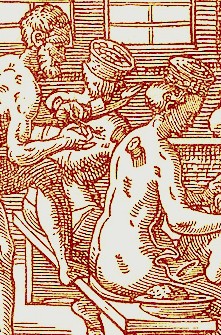
Artist: Jost Amman
Cupping, From Das Standebuch (1586)
Bloodletting in this manner relied on the body to eject the blood. Bloodletting using cupping glasses added an extra, sometimes useful element to the bleeding process: the surgeon was able to make incisions in the skin and then use the cupping glass to draw blood out.
As suggested in the introduction, cupping was often an alternative choice for extracting blood, although some authors preferred it for certain situations. French surgeon Ambroise Paré explained that cupping vessels were "applied especially when the matter conjunct and impact [joined forcefully together] in anie part is to bee evacuated"5. So it could be used anywhere, with the cupping glasses allowing for targeted location work. Surgical tool historian Elizabeth Bennion points out the versitility of dry cupping, explaining that cupping glasses could more easily be used in locations like "the temples, behind the ears, and the base of the spine"6.
Of course, extracting blood wasn't the only way to alter the humoral concentrations in the body. Sometimes it was felt that it was enough to just relocate offending humors to another place. Two processes for diverting humors in this way were used, but before we can look at them, we must first discuss the differences between wet and dry cupping.
1,2,3,4 Hippocrates, The Writings of Hippocrates and Galen, Translated and Edited by John Redmond Coxe, p. 150; 5 Ambroise Paré, The Workes of that Famous Chirurgion Ambrose Parey, p. 443; 6 Elizabeth Bennion, Antique Medical Instruments, p. 44;

